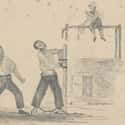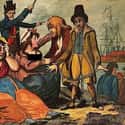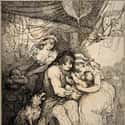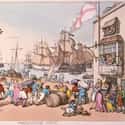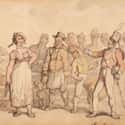(#8) The Lady Juliana Provided Better Living Conditions Than Other Convict Ships And British Prisons
The women aboard the Lady Juliana came from British prisons. Though a prison reform movement began to grow in the late 18th century, the prison conditions they escaped were deplorable. Prisons were overcrowded, and diseases spread swiftly.
It was still a prison ship, and most of the passenger-convicts slept just above the ship's garbage and sewage deck. But the women of the Lady Juliana had something that their land-imprisoned counterparts didn't: consistent access to medical care. The ship had a surgeon and was kept relatively clean.
Also, the women weren't chained up like prisoners on other convict ships, and they could barter for improved conditions through various favors. John Nicol credited the ship's captain with being "a humane man" who "did all in his power to make the convicts as comfortable as their circumstances would allow."
Part of the reason the passengers on the Lady Juliana enjoyed better conditions was because the British government oversaw it, unlike the other ships in the Second Fleet. All the other vessels were operated by Camden, Calvert, and King, a notorious and prolific slave trading company. Only five women perished aboard the Lady Juliana, compared to the 267 deaths reported by the other ships.
(#12) The Women On The Ship Had To Wear Convict Dresses
As prisoners, the women going to Australia on the Lady Juliana were expected to wear convict dresses. At least one fashionable prisoner protested this. According to the ship's steward, Elizabeth Barnsley actually "petitioned the government agent and captain to be allowed to wear her own clothes" while the ship prepared to sail. Her request was denied, but the crew allowed her to wear whatever she wanted once the boat went to sea.
Since the convicts all wore issued dresses, the ship's captain had the right to dispose of all the passengers' clothing - but he didn't, and instead held it for them. He reasoned that the garments "would be of use to the poor creatures when they arrived at Port Jackson."
(#13) Some Of The Women Brought Their Children, And Others Gave Birth On The Way
Some of the women aboard the Lady Juliana were already mothers before the ship departed England, and so they brought their children with them. Many of the convict-passengers became pregnant and even gave birth during the long voyage.
Historians generally believe five to seven babies were born on the ship, but steward John Nicol suggested no less than 20 had been born while the ship was in port at Rio. They were prepared for the births - the ship had received a small donation of baby linens before leaving England.
(#3) Colonial Officials Wanted The Women To Prevent Men From Sleeping With Each Other
There was not an even distribution of men and women among the convict-colonists in early British Australia. Of the 759 convicts sent to Australia aboard the First Fleet, 568 were men while only 191 were women. As a result, officials worried about how all those men would find partners - some were concerned that they would turn to one another.
To correct what 18th-century Britain perceived to be "gross irregularities" in romantic partnerships in Australia, officials begged for more women. In other words, the women of the Lady Juliana were meant to be sex objects and wives for male officers and convicts.
(#1) Some Of The Passengers Sold Themselves At Ports En Route To Australia
The voyage to Australia lasted about 10 months, as the Lady Juliana voyaged from port to port in the Atlantic and Indian Oceans. The ship's stays in places like Rio de Janeiro and Cape Town could last several weeks. The convicts made the most of their global tour by selling their services in these ports.
As John Nicol, the ship's steward, euphemistically remembered, "We did not restrain the people on shore from coming on board through the day. The captains and seamen, who were in port at the time, paid us many visits."
The ladies kept at least part of their earnings. Some of the ship's officers and sailors allegedly even got in on the business, and their involvement raises serious questions about the degree to which these captive women were coerced into their activities.
(#7) Some Of The Women Might Have Been Sex Workers In England
Though they were not being transported to New South Wales for prostitution, many of the women aboard the Lady Juliana may have been ladies of the night. A robust harlotry economy existed in 18th-century Britain, so it's reasonable to assume that some of the 200-plus convicts took part.
Moreover, many of the passengers' stories fell into the "fallen woman" trope that had become popular in novels and plays. John Nicol believed many of the women had been seduced at some point in their lives. He wrote about how Sarah Dorset, for example, had "fallen" into a life of alleged folly and sin:
She had not been protected by the villain that ruined her above six weeks; then she was forced by want upon the streets, and taken up as a disorderly girl; then sent onboard to be transported.
New Random Displays Display All By Ranking
About This Tool
In 1787, Britain began to colonize Australia. The British government licensed the lady Juliana to transport nearly 300 prisoners to Australia. Most of the prisoners on this ship were London prostitutes, and some ordinary criminals, such as thieves and shoplifters. The prisoner ship "Lady Juliana" arrived in Sydney in the winter of 1790. It was one of the slowest prisoner ships in history.
The unbelievable thing is that most of the women were pregnant when they landed, because almost every man on this ship had sex with female prisoners, and many had already given birth to children at sea. The lady Juliana was also famous for the "mobile brothel". The random tool brings us to know 14 wild stories of the lady Juliana.
Our data comes from Ranker, If you want to participate in the ranking of items displayed on this page, please click here.











